Birds are a vital part of the Southwest’s wildlife. With the region’s diverse habitats and climates, many species of birds call the Southwest home.
Various species can be found in the area, from the desert regions of Arizona and New Mexico to the mountains of Colorado and Utah. The Southwest is home to different bird species, from the majestic bald eagle to the brightly-colored hummingbird.
This introduction will explore the variety of birds in the Southwest and provide an overview of their habitats and behaviors.
24 Birds to Watch in Southwest
The Southwest is a region of diverse landscapes, climates, and wildlife. From the arid deserts of Arizona and New Mexico to the lush forests of Colorado and Utah, the Southwest offers a variety of habitats for birds.
Whether you are a beginner or an expert birdwatcher, you will find plenty of opportunities to observe and enjoy the avian life of the Southwest. Here are 24 birds to watch in the Southwest.
1. Cactus Wren
The cactus wren is a species of wren that is found only in the deserts of the southwestern United States and northern and central Mexico. It is a unique bird closely associated with the desert and is an iconic symbol of Arizona, where it is the official state bird.
The cactus wren is the largest wren species in the United States, and it is easily identified by its brown plumage, which is decorated with distinct black and white spots.
This species is also known for its loud and complex call, often heard echoing through the deserts of the southwestern United States. The cactus wren is an important species of bird, both culturally and ecologically.
It helps control insect populations in the desert, which helps balance the delicate desert ecosystem. Additionally, the cactus wren is a beloved symbol of the desert and is a reminder of the beauty and uniqueness of the southwestern United States.
| Kingdom | Animalia |
| Phylum | Chordata |
| Class | Aves |
| Order | Passeriformes |
| Family | Troglodytidae |
| Genus | Campylorhynchus |
| Species | C. brunneicapillus |
2. Northern Cardinal
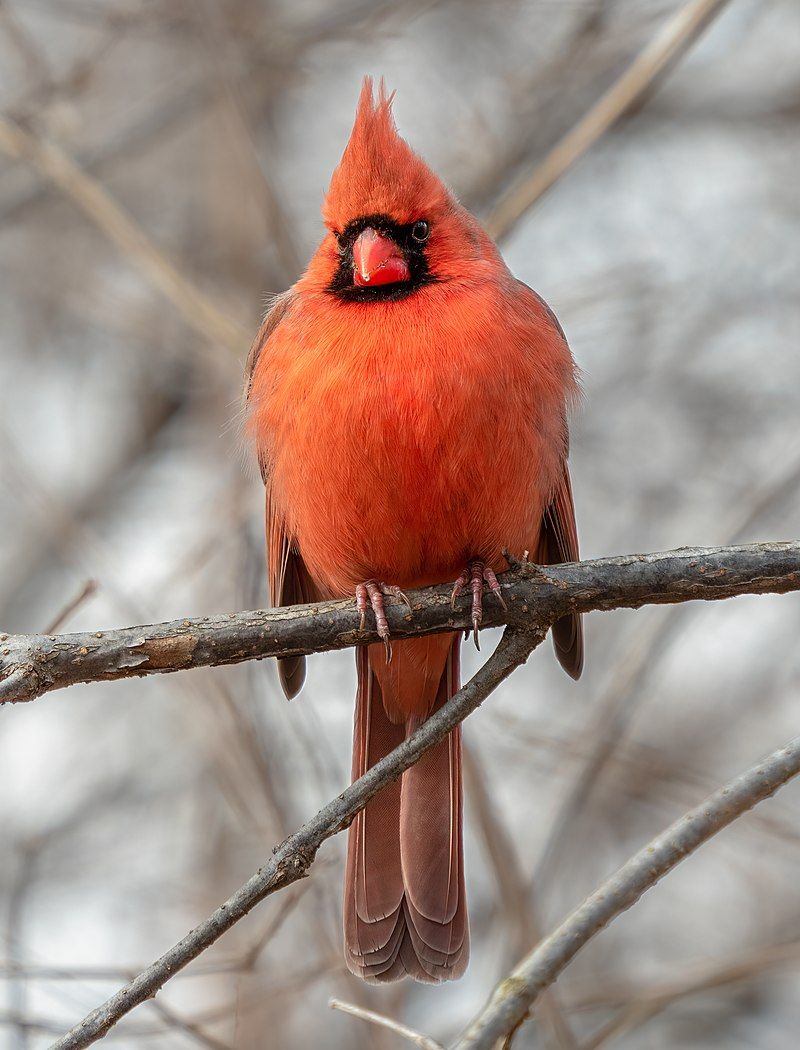
The northern cardinal is a common sight in many parts of North America and is easily recognizable by its bright red feathers.
It is a member of the Cardinalis and is also known by several names, including the redbird, the common cardinal, the red cardinal, and simply the cardinal.
The northern cardinal is a medium-sized songbird, typically measuring 8-9 inches long and having a wingspan of up to 10 inches. It has a pointed crest, a black mask, and a red bill.
The male has a bright red body with black feathers on the wings and tail, while the female is mostly brownish-grey with some red on its wings and tail. Both sexes have a black bill and a red eye.
The northern cardinal is a year-round resident, and its song is a loud, clear whistle that can be heard year-round. It feeds mainly on seeds, fruits, insects, and other small invertebrates.
In addition to its bright red plumage, the northern cardinal is also known for its territorial behavior and is often seen chasing away other birds from its territory.
The northern cardinal is an integral part of North American birdlife,, a pleasure to observe, and an essential part of the local ecosystem.
| Kingdom | Animalia |
| Phylum | Chordata |
| Class | Aves |
| Order | Passeriformes |
| Family | Cardinalidae |
| Genus | Cardinalis |
| Species | C. cardinalis |
3. House Finch
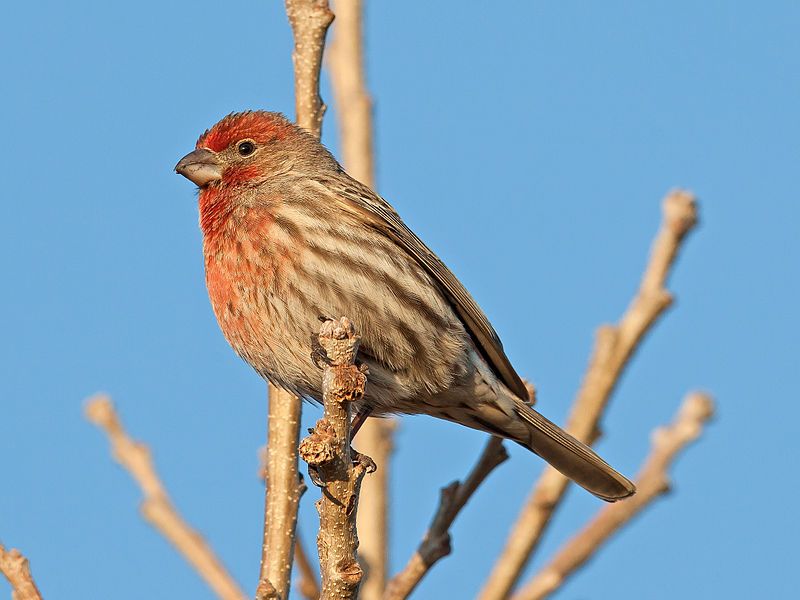
The house finch is a species of bird that belongs to the finch family known as Fringillidae. It is native to western North America and has been introduced to the eastern half of North America and even Hawaii.
The house finch is part of a larger genus of birds called Haemorhous, including two other species of American rosefinches. This genus is characterized by its colorful plumage and hardy nature, making it a famous bird for birdwatchers.
The house finch is a lively bird often seen in yards and gardens, flitting from branch to branch and singing its cheerful tune. It has an affinity for bird feeders and often gathers in large flocks around them.
The house finch is an integral part of North America’s avian ecology and is an exciting and delightful bird to observe.
| Kingdom | Animalia |
| Phylum | Chordata |
| Class | Aves |
| Order | Passeriformes |
| Family | Fringillidae |
| Genus | Haemorhous |
| Species | H. mexicanus |
4. White-winged Dove
The white-winged dove is a species native to the Southwestern United States, Mexico, Central America, and the Caribbean.
These birds are larger than the average dove and have a unique white edge on their wings, making them stand out from other doves.
Additionally, they have light blue eyering and vibrant red eyes, further distinguishing them from other species. These birds are found in various habitats, from open woodlands to deserts and wetlands.
They are also known to be quite vocal, with their distinctive calls heard in the early morning hours. These birds can be seen flying in small flocks or pairs, often gathering in large numbers in open fields.
White-winged doves are essential to the region’s ecology, as they feed on seeds and fruits, helping to disperse them throughout the environment.
| Kingdom | Animalia |
| Phylum | Chordata |
| Class | Aves |
| Order | Columbiformes |
| Family | Columbidae |
| Genus | Zenaida |
| Species | Z. asiatica |
5. Red-winged Blackbird
The red-winged blackbird is an extraordinary species of bird that can be found across North America and Central America. It belongs to the family Icteridae, a group of birds that includes a variety of species, including grackles, cowbirds, and orioles.
This blackbird species is known for its distinctive red-and-black coloring, and the males are particularly striking with their bright red shoulder patches.
The red-winged blackbird is a passerine bird, meaning it has three toes pointing forward and one toe pointing back, which allows it to perch on branches.
The red-winged blackbird is common across its range and can often be found in wetlands, grasslands, and agricultural areas. During the breeding season, the males can be heard singing their distinctive song from the top of tall trees or posts.
The song usually includes a loud “konk-la-ree” or “conk-a-ree” call followed by a series of chirps. While they are most often seen in large flocks, during the breeding season, the males establish territories and aggressively defend them from intruders.
This species is an omnivore, which eats plant and animal matter. The red-winged blackbird typically feeds on various insects, grain, and other small invertebrates. It is an essential species for farmers, helping to keep pest populations in check.
The red-winged blackbird is a resilient species that can adapt to various meats, making it a thriving species in its range.
| Kingdom | Animalia |
| Phylum | Chordata |
| Class | Aves |
| Order | Passeriformes |
| Family | Icteridae |
| Genus | Agelaius |
| Species | A. phoeniceus |
6. American Goldfinch
The American goldfinch is a small bird that belongs to the finch family. It is found in North America, and its range is quite vast. During the breeding season, it can be observed in areas stretching from mid-Alberta to North Carolina.
During the winter, it migrates south and can be seen in areas bordering the Canada-United States border and even in Mexico. The American goldfinch has adapted to its migratory nature, allowing it to survive in different climates and during various times of the year.
It can adjust to changing temperatures and thrive in warm and cold climates.
This is important for the survival of this species, as it ensures that it has access to food and resources all year round. The American goldfinch is a beautiful species with distinctive yellow and black plumage.
Its diet consists of various items, including seeds, insects, and fruits. During the winter, its diet mainly comprises seeds, which it can find in abundance in the areas it travels to.
The American goldfinch is an important species to our environment, and it is essential to protect it. Conservation efforts are necessary to ensure that this species can thrive and their populations remain healthy.
By taking the necessary steps to protect this species, we can help ensure that the American goldfinch will be around for many years.
| Kingdom | Animalia |
| Phylum | Chordata |
| Class | Aves |
| Order | Passeriformes |
| Family | Fringillidae |
| Genus | Spinus |
| Species | S. tristis |
7. Northern Mockingbird
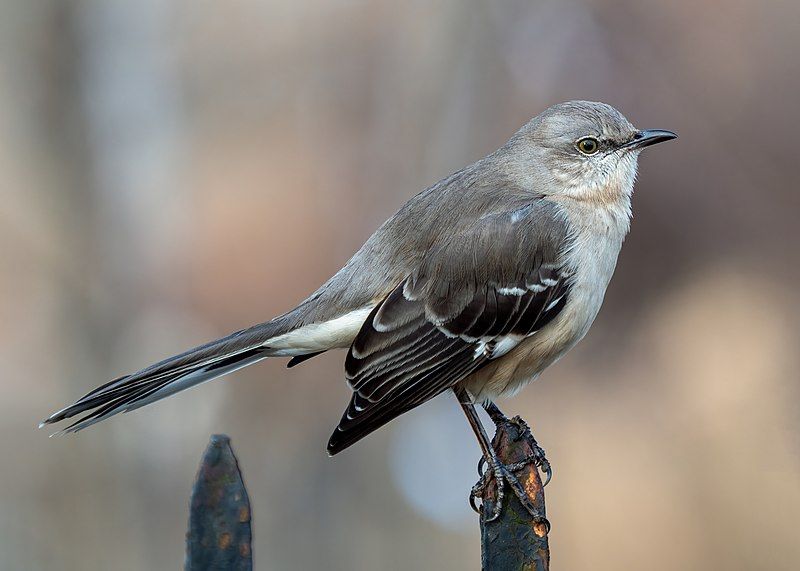
The northern mockingbird is a species of mockingbird commonly found in North America. This bird is mainly a permanent resident but may migrate southwards during harsh weather conditions.
Interestingly, this species has rarely been observed in Europe, suggesting it is not a regular visitor. The northern mockingbird is well adapted to its natural environment in North America, possessing the ability to survive in various habitats.
It is a vocal bird, capable of singing various melodic songs, and its ability to imitate the sounds of other birds makes it a popular species to observe in its natural habitat.
The northern mockingbird is a graceful bird with primarily white or gray plumage, and its wings and tail are lined with dark feathers. This species is also known to be quite protective of its territory and will aggressively defend it from intruders.
| Kingdom | Animalia |
| Phylum | Chordata |
| Class | Aves |
| Order | Passeriformes |
| Family | Mimidae |
| Genus | Mimus |
| Species | M. polyglottos |
8. Dark-eyed Junco
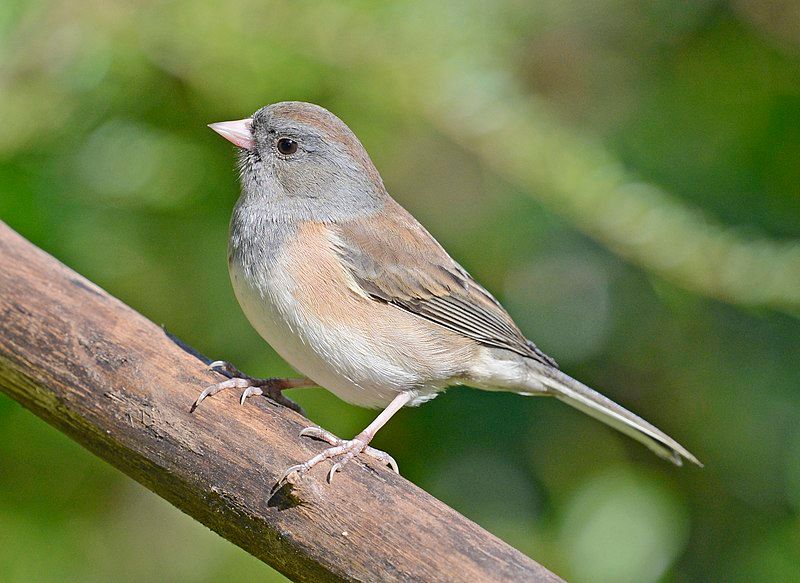
The dark-eyed junco is a species of small bird native to North America. It is classified as a type of sparrow and is most commonly found in temperate climates throughout the continent. These birds can be seen far into the Arctic region in the summer months.
The dark-eyed junco is known for its variability and is often compared to the fox sparrow due to its similar characteristics. Despite its widespread presence, the full systematics of the dark-eyed junco remain unclear and are still being studied.
| Kingdom | Animalia |
| Phylum | Chordata |
| Class | Aves |
| Order | Passeriformes |
| Family | Passerellidae |
| Genus | Junco |
| Species | J. hyemalis |
9. Song Sparrow
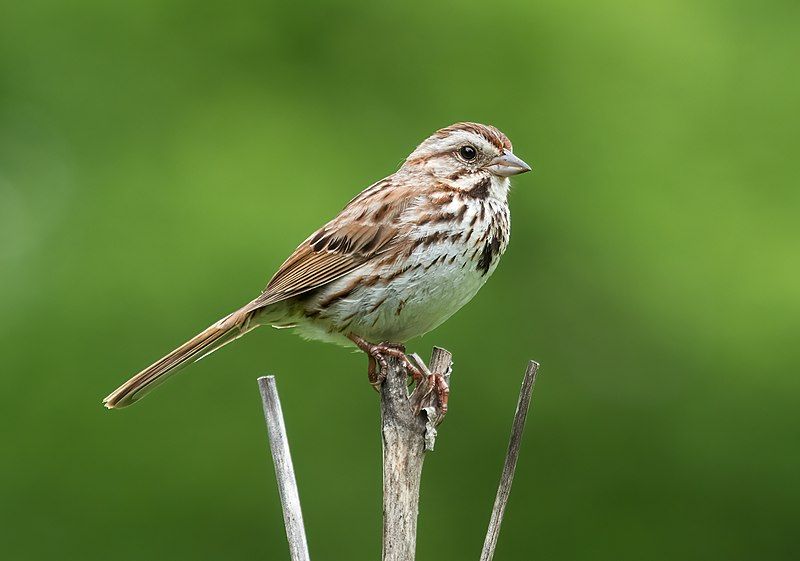
The song sparrow is a species of sparrow native to the New World. It is a medium-sized bird and is one of North America’s most abundant species of sparrows.
The song sparrow is also one of the most adaptable species of birds in the region, with a wide variety of habitats in which it can thrive. It is most commonly found in open fields, wetlands, and woodlands but also in urban areas.
The song sparrow is also highly variable in its appearance, boasting various colors and patterns depending on its location. The bird also has a variety of vocalizations, allowing it to communicate effectively with other members of its species.
The song sparrow is highly successful in its environment thanks to its adaptability, abundance, and variability.
| Kingdom | Animalia |
| Phylum | Chordata |
| Class | Aves |
| Order | Passeriformes |
| Family | Passerellidae |
| Genus | Melospiza |
| Species | M. melodia |
10. Yellow-rumped Warbler
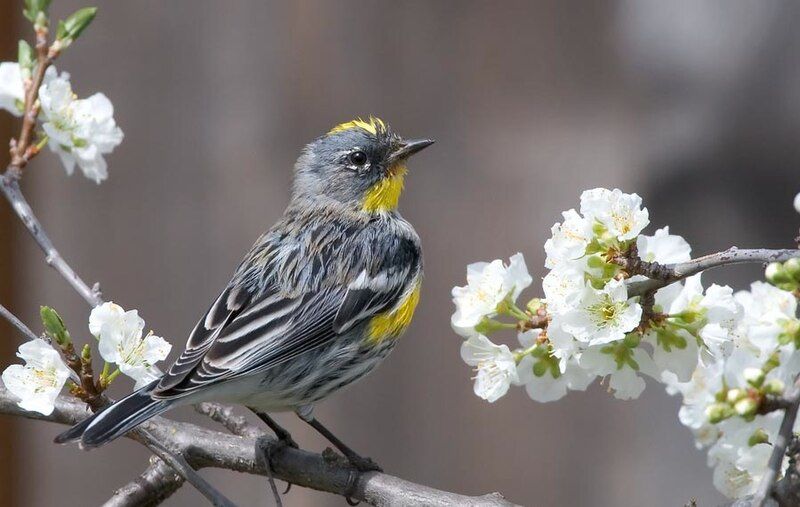
The yellow-rumped warbler is a bird species regularly found across North America. It is one of the most widespread bird species in the continent, inhabiting a wide range of habitats from woodlands to marshlands.
This species is easily identifiable due to its unique yellow rump and black-streaked white breast. It is a small bird, measuring around 4.5 to 5.5 inches long, with a wingspan of 7.5 to 9 inches.
This species is commonly seen all across North America, from Canada to the southern United States. During the breeding season, these birds inhabit areas with dense shrubs and trees, including forests, woodlands, and suburban gardens.
During the migratory season, they can be seen in habitats such as open areas, marshes, and shorelines. The yellow-rumped warbler is an omnivorous bird, eating a variety of insects, fruits, seeds, and berries.
It is an active forager, often seen fluttering from branch to branch in search of food. The males of this species are known to sing various songs, which they use to attract mates and defend their territories.
All in all, the yellow-rumped warbler is a widespread species that can be found in a variety of habitats across North America. Its unique yellow rump and vocalizations make it a fascinating species to observe, and its presence is a welcome sight in many areas.
| Kingdom | Animalia |
| Phylum | Chordata |
| Class | Aves |
| Order | Passeriformes |
| Family | Parulidae |
| Genus | Setophaga |
| Species | S. coronata |
11. Greater Roadrunner
The Greater Roadrunner is a species of bird belonging to the Cuculidae family, also known as the cuckoo family. It is native to the Aridoamerica region, a vast area encompassing the Southwestern United States and Mexico.
The scientific name of this species is Geococcyx californianus, which translates to “Californian earth-cuckoo.” Along with the Lesser Roadrunner, this species is part of the Genus Geococcyx. The Greater Roadrunner is a large bird with long legs and tail.
It is usually brown, with white and black markings. It has a long, curved bill and a crest on its head. The Greater Roadrunner is an omnivore which eats plants and animals. Its diet includes insects, lizards, snakes, mice, birds, eggs, and fruits.
It is also known to scavenge for food, such as carrion. The Greater Roadrunner is a ground-dwelling bird usually found in open, arid habitats. It is diurnal, active during the day and roosts at night.
It is a fast runner capable of reaching up to 25 miles per hour. It is also a strong flyer and can travel up to 500 miles daily. The Greater Roadrunner is an essential ecosystem species as it helps control insect and rodent populations.
It is also an essential cultural symbol in art and literature throughout the Southwestern United States. It has been featured in numerous films and television shows and is the mascot of New Mexico State University.
| Kingdom | Animalia |
| Phylum | Chordata |
| Class | Aves |
| Order | Cuculiformes |
| Family | Cuculidae |
| Genus | Geococcyx |
| Species | G. californianus |
12. Costa’s Hummingbird
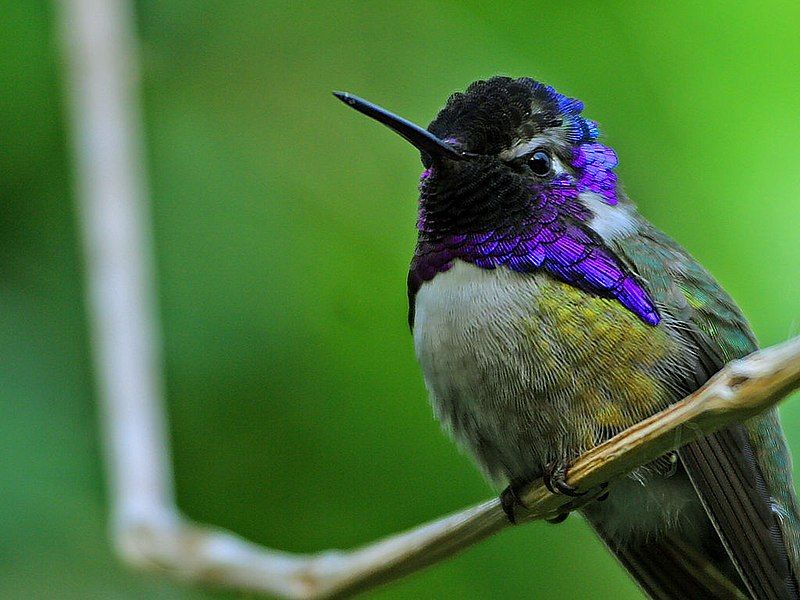
Costa’s hummingbird is a small bird species belonging to the Trochilidae family. It is native to the arid regions of the southwestern United States and northwestern Mexico.
During winter, it migrates south into western Mexico, where the climate is more suitable for its needs. This species is a small bird with a length of just over three inches and a wingspan of four inches.
The males are a brilliant green color with a bright red forehead and throat patch, while the females are a duller green with white markings. Costa’s hummingbird has various habitats, including deserts, grasslands, and forests.
It feeds mainly on nectar from a variety of flower species, as well as small insects. It has a swift flight, its wings beating around 80 times per second. The males are known to be quite territorial, often chasing away intruders from their feeding areas.
This species is listed as Least Concern on the IUCN Red List, as its population is stable and not in decline. This is likely due to its wide range and adaptability to various habitats.
Protecting this species is essential to protect its habitats from destruction and pollution. Additionally, it is necessary to safeguard the nectar-producing flowers that it relies on for food.
| Kingdom | Animalia |
| Phylum | Chordata |
| Class | Aves |
| Clade | Strisores |
| Order | Apodiformes |
| Family | Trochilidae |
| Genus | Calypte |
| Species | C. costae |
13. Broad-billed Hummingbird
The broad-billed hummingbird is a small-sized bird native to Mexico and the southwestern United States. It displays sexual dimorphism, meaning that the males and females have different physical characteristics.
The male has an impressive bright red bill, while the female has a smaller bill with a more subtle coloration. Juveniles of the species resemble the female more than they do the male.
The broad-billed hummingbird is a brightly colored bird, with its distinctive red bill being the most notable feature. The bill is broad and a vital species identifier.
The bright color of the bill is also a key identifier, making it easy to spot amongst other species. The broad-billed hummingbird is a fascinating species and is an integral part of the southwestern United States and Mexico ecology.
| Kingdom | Animalia |
| Phylum | Chordata |
| Class | Aves |
| Clade | Strisores |
| Order | Apodiformes |
| Family | Trochilidae |
| Genus | Cynanthus |
| Species | C. latirostris |
14. Blue Jay
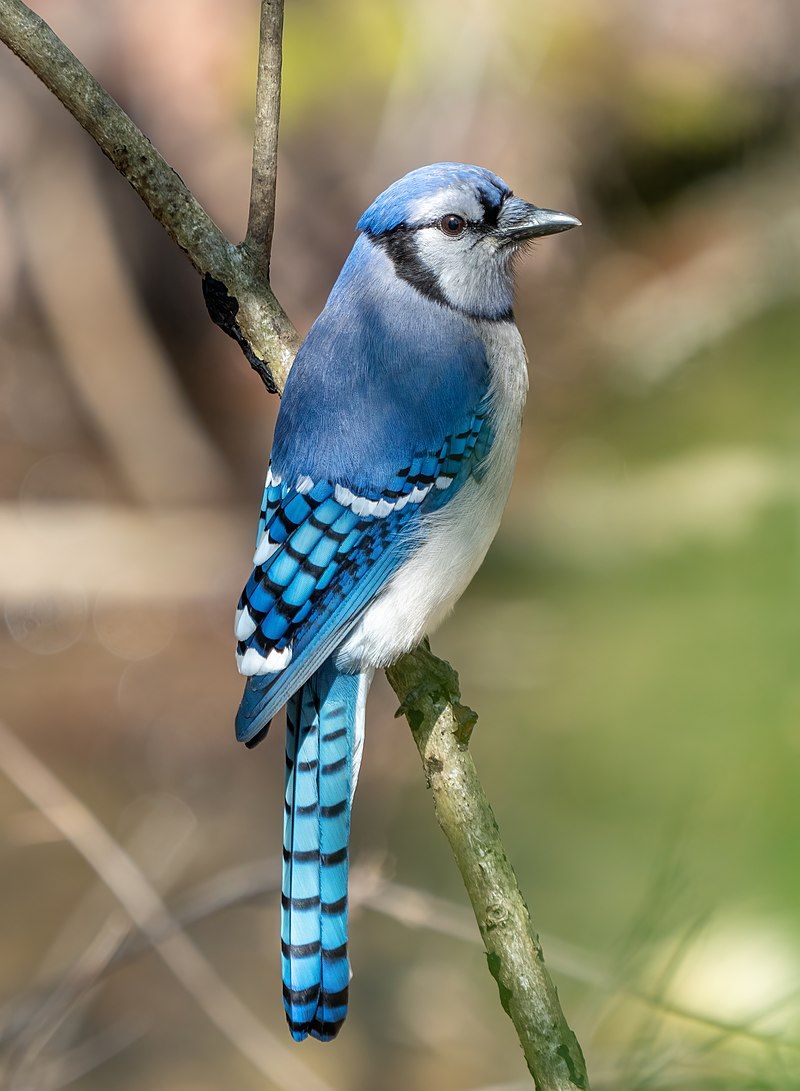
The blue jay is a medium-sized bird from the Corvidae family, native to eastern North America. Its range stretches from the central United States to Newfoundland in Canada. It is also found in southern Canada, where it breeds in the summer months.
Blue jays are primarily non-migratory. However, some eastern populations may migrate during the winter. They are adaptable birds in various habitats, such as woodlands, gardens, and suburban parks.
Blue jays are omnivorous, feeding on various foods such as nuts, fruits, insects, and even other small birds. They are also known to be intelligent birds, capable of solving complex problems and remembering the solutions for future use.
They are an essential part of the ecosystem, helping to disperse the seeds of many plants and controlling the populations of specific insect species.
| Kingdom | Animalia |
| Phylum | Chordata |
| Class | Aves |
| Order | Passeriformes |
| Family | Corvidae |
| Genus | Cyanocitta |
| Species | C. cristata |
15. Verdin
The verdin is a small bird that belongs to the family of penduline tits. It is the only species in its genus, Auriparus, that is unique to the Old World family of Remizidae. This makes the verdin the only representative of the Remizidae family in North America.
This tiny bird is usually found in desert and dry grassland areas, where it builds its nest from grass, feathers, and other materials found in its environment. Its diet consists of insects, other small invertebrates, and some fruits and seeds.
The verdin is also known for its distinctive “tseep” call, made in various contexts, including courtship. This tiny bird plays an essential role in its ecosystem, as it helps to keep insect populations in check and disperse seeds.
| Kingdom | Animalia |
| Phylum | Chordata |
| Class | Aves |
| Order | Passeriformes |
| Family | Remizidae |
| Genus | Auriparus |
| Species | A. flaviceps |
16. Anna’s Hummingbird
Anna’s hummingbird is a species native to western coastal regions of North America. It was named after Anna Masséna, Duchess of Rivoli, and is one of the most widespread hummingbird species in the United States.
Anna’s hummingbird is a small bird, measuring 3 and 4 inches long and weighing around 3 to 5 grams.
Its body is mainly green, with white undersides and a deep red throat patch. In the early 20th century, the Anna’s hummingbird was found primarily in California and Baja California.
It is believed that the bird only bred in the northern part of Baja California and Southern California at that time. As the years passed, the hummingbird’s range expanded, and its presence was seen in more states and provinces.
Today, Anna’s hummingbird can be found in the western United States, Canada, and parts of Mexico. It has also been seen in many other parts of the country, including the southern states of Arizona, New Mexico, and Texas.
| Kingdom | Animalia |
| Phylum | Chordata |
| Class | Aves |
| Clade | Strisores |
| Order | Apodiformes |
| Family | Trochilidae |
| Genus | Calypte |
| Species | C. anna |
17. Gambel’s Quail
Gambel’s quail is a small bird species in the New World quail family. It is found in several desert regions of the United States, including Arizona, California, Colorado, New Mexico, Nevada, Utah, and Texas.
It can also be found along the Colorado River in the Mexican states of Sonora, Chihuahua, and Baja, California. This bird is a ground-dweller, preferring to spend time on the ground rather than in trees.
It is well adapted to its desert environments, with a diet consisting of seeds, berries, insects, and other small prey. Furthermore, this bird also has distinctive plumage, with a dark gray head and a white eye stripe.
Additionally, males have a black belly and a chestnut-brown back, while females have a light tan chest and a white belly. This quail species is also known for its loud call, often alerting other birds of its presence.
| Kingdom | Animalia |
| Phylum | Chordata |
| Class | Aves |
| Order | Galliformes |
| Family | Odontophoridae |
| Genus | Callipepla |
| Species | C. gambelii |
18. Tufted Titmouse
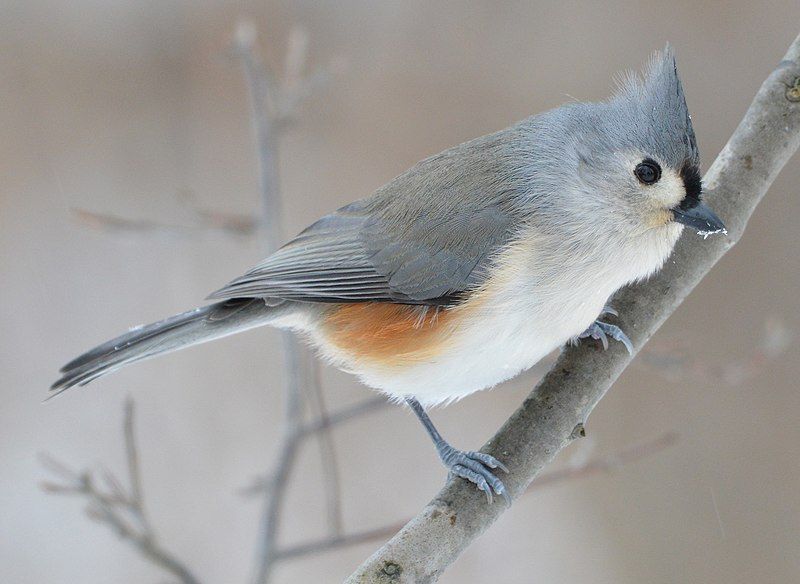
The tufted titmouse is a small songbird that is native to North America and belongs to the tit and chickadee family. It is characterized by its distinctive black crest and tufted head. The black-crested titmouse is a related species found in central and southern Texas.
It was once classified as a subspecies of the tufted titmouse, but it is now considered a distinct species, referred to as Baeolophus atricristatus. This species is easily distinguished from the tufted titmouse by its smaller size, blacker plumage, and lack of a crest.
Its different songs and calls also distinguish it. Both species are similar in their habitat preferences and can be found in woodlands, parks, and suburban areas.
| Kingdom | Animalia |
| Phylum | Chordata |
| Class | Aves |
| Order | Passeriformes |
| Family | Paridae |
| Genus | Baeolophus |
| Species | B. bicolor |
19. Brown-headed Cowbird
The brown-headed cowbird is a species of icterid bird native to temperate and subtropical North America. It is a small bird that has adapted to a lifestyle of brood parasitism, meaning that it lays its eggs in the nests of other birds to have its young raised by them.
The brown-headed cowbird is a permanent resident in the southern regions of its range. In contrast, in the northern parts of its range, the birds migrate to the south of the United States and Mexico in winter before returning to their summer habitat around March or April.
This adapts to the colder climates of the northern parts of the species’ range. The brown-headed cowbird is a fascinating species, and its habits of brood parasitism have greatly influenced the ecology of the regions it inhabits.
| Kingdom | Animalia |
| Phylum | Chordata |
| Class | Aves |
| Order | Passeriformes |
| Family | Icteridae |
| Genus | Molothrus |
| Species | M. ater |
20. California Condor
The California condor is a majestic bird native to the western United States. It is the giant North American land bird and is a New World vulture family member.
Sadly, the species was driven to extinction in the wild in 1987 when the remaining individuals were captured. Since then, a successful captive breeding program has been implemented, and more than 400 California condors are living in the wild.
By 2010, the population had grown to over 300 individuals. The continued growth of the species is due to the combined efforts of wildlife experts, conservationists, and dedicated volunteers.
The California condor’s recovery is a remarkable success story and a testament to the power of conservation. However, the species faces myriad threats, from habitat destruction to lead poisoning.
To ensure the species’ long-term survival, continued conservation efforts must be made to protect its habitat and minimize the presence of lead in the environment.
| Kingdom | Animalia |
| Phylum | Chordata |
| Class | Aves |
| Order | Accipitriformes |
| Family | Cathartidae |
| Genus | Gymnogyps |
| Species | G. californianus |
21. Bald Eagle
The bald eagle is a majestic bird of prey that can be found mainly in North America. It is a sea eagle and is classified into two distinct subspecies.
It forms a species pair with the white-tailed eagle, similar to the bald eagle in its habitat and niche in the Palearctic region. The bald eagle is an impressive bird with a wingspan of up to seven feet and a weight of up to fifteen pounds.
Its distinctive features include a white head, neck, tail, yellow beak, and feet. It is a mighty and skilled hunter and feeds on fish, small mammals, and other birds. It is a symbol of strength and freedom and is the national bird of the United States.
| Kingdom | Animalia |
| Phylum | Chordata |
| Class | Aves |
| Order | Accipitriformes |
| Family | Accipitridae |
| Genus | Haliaeetus |
| Species | H. leucocephalus |
22. Gila Woodpecker
The Gila woodpecker is found in the desert regions of the southwestern United States and western Mexico. These birds have medium-sized bodies, ranging in size from 7-7.5 inches in length and weighing around 1.5 ounces.
They have a light-brown head with a black stripe on the back, white underparts, and a grayish-brown back. In the United States, they range through southeastern California, southern Nevada, Arizona, and New Mexico.
In the wild, they are often seen on saguaro cacti, where they feed on the insects that live in the crevices of the cactus. They also feed on other insects, seeds, fruits, and other plant material. Gila woodpeckers are social birds and often live in small groups.
During the nesting season, they build their nests in cavities in the cactus. They line the cavity with wood chips or cactus fibers.
The female usually lays four to five white eggs and incubates them for about two weeks, during which time the male will feed both her and the young. In recent years, the Gila woodpecker has become a conservation concern due to habitat destruction and illegal trapping for the pet trade.
Conservation efforts are underway to protect this species and other woodpecker species from further decline.
| Kingdom | Animalia |
| Phylum | Chordata |
| Class | Aves |
| Order | Piciformes |
| Family | Picidae |
| Genus | Melanerpes |
| Species | M. uropygialis |
23. Gray Catbird
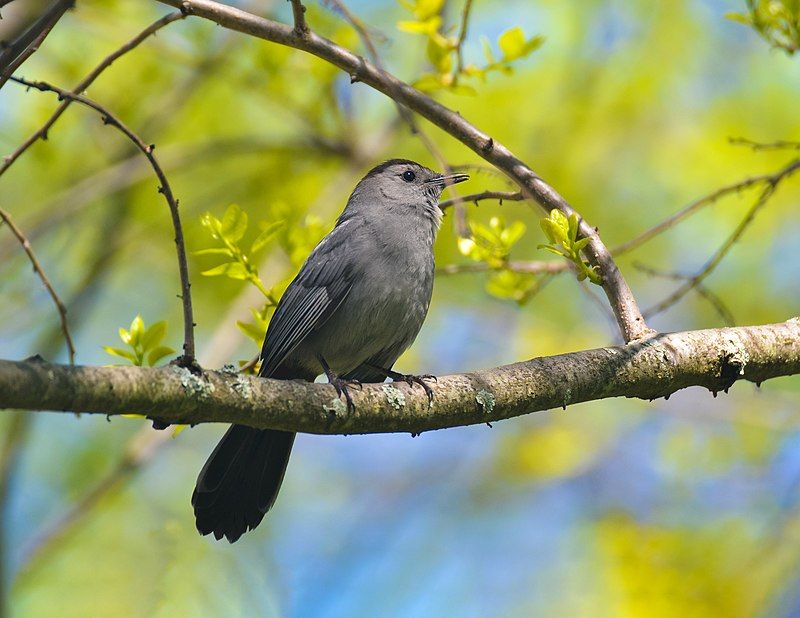
The gray catbird is a unique bird species found throughout North America and Central America. It is a medium-sized bird belonging to the mimid family and is the only member of the catbird genus Dumetella.
The gray catbird is known for its distinctive gray coloring and its melodious song. It is a ground-dwelling bird that prefers to live in thick shrub and brushy areas and is often seen foraging for food on the ground or in low-growing vegetation.
The gray catbird is a highly adaptable species found in various habitats, from urban parks to rural woodlands. It has a wide range of diets consisting of insects, berries, and seeds.
The gray catbird is an integral part of the local ecology, as it helps to control insect populations and disperse the seeds of plants. It is also known to be a social bird, often seen in flocks with other species of birds.
| Kingdom | Animalia |
| Phylum | Chordata |
| Class | Aves |
| Order | Passeriformes |
| Family | Mimidae |
| Genus | Dumetella |
| Species | D. carolinensis |
24. Western Bluebird
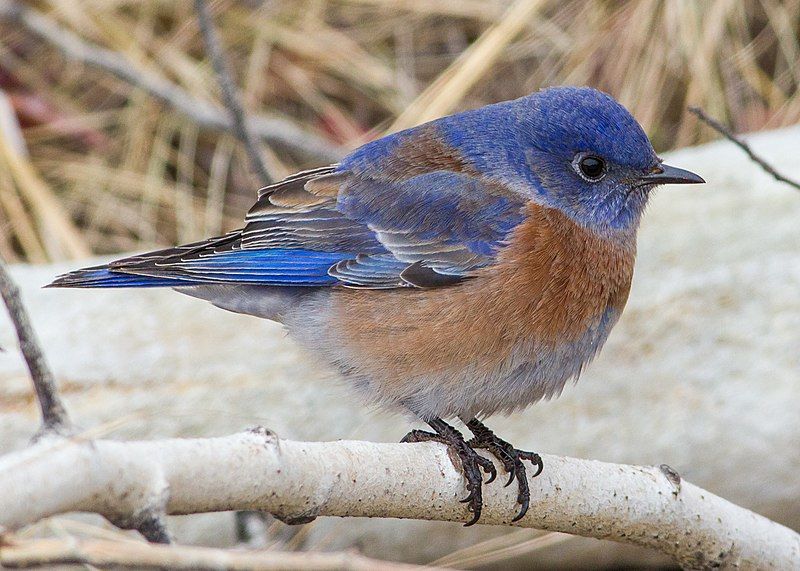
The western bluebird is a species of small North American thrush found in the western parts of the continent. It is a migratory species found in various habitats ranging from coniferous forests to open meadows.
The western bluebird is a medium-sized songbird with a stocky body, short legs, and a short tail. Its head is grayish-blue with a slightly darker blue on its throat, wings, and tail. The male has a bright red breast, while the female has a grayish-blue breast.
The western bluebird feeds mainly on insects but eats fruits, berries, and seeds. It is known to form strong pair bonds, and the males will often help feed the pair’s young.
The western bluebird is an important species for maintaining healthy ecosystems, helping to control insect populations, and providing food for other species.
| Kingdom | Animalia |
| Phylum | Chordata |
| Class | Aves |
| Order | Passeriformes |
| Family | Turdidae |
| Genus | Sialia |
| Species | S. mexicana |
Conclusion
Birds in the Southwest are a diverse and vibrant part of the region’s ecology and an essential part of the region’s natural beauty.
From the colorful hummingbirds of the desert to the majestic bald eagles of the mountains, a wide variety of birds inhabit this region.
These birds are essential to the region’s ecology and provide an important source of beauty and enjoyment to those who live in the area.
There is much to be learned from the birds of the Southwest, and we should all work to ensure that these birds are protected and their habitats are preserved.